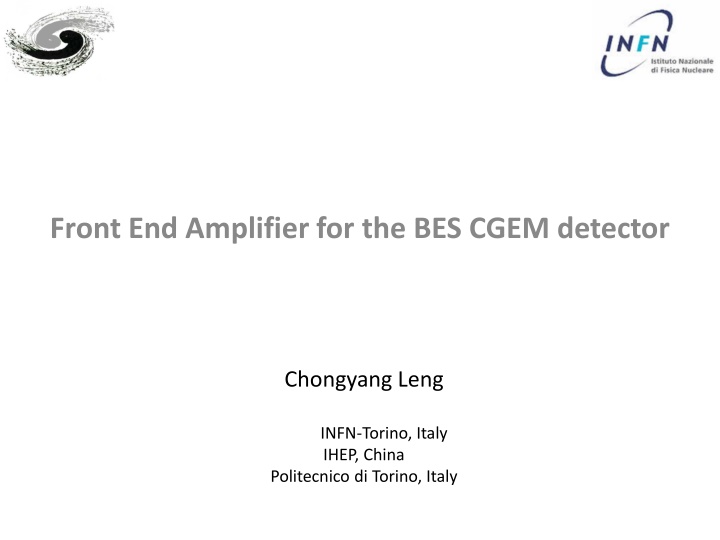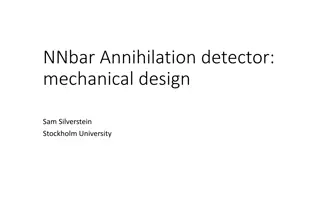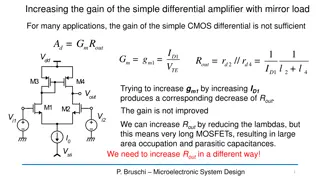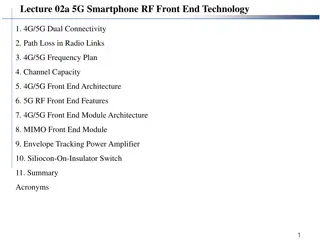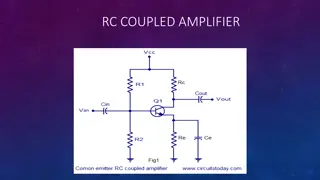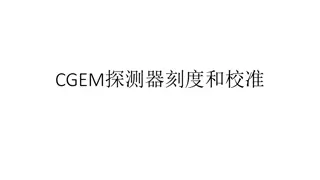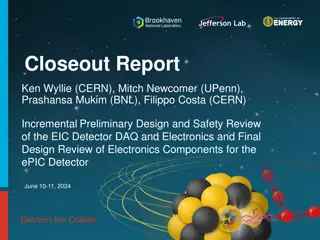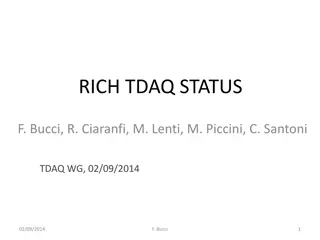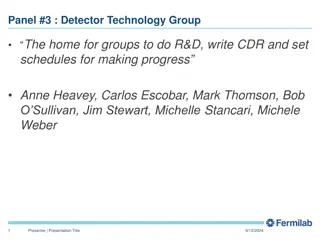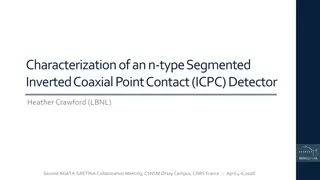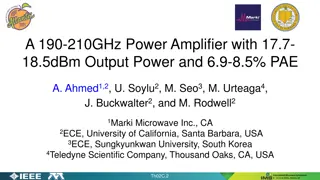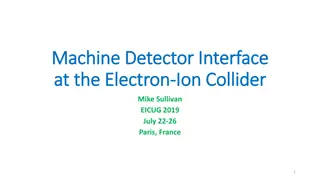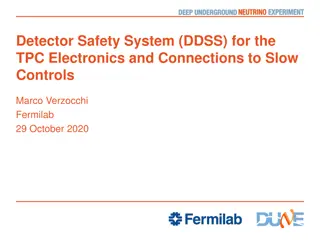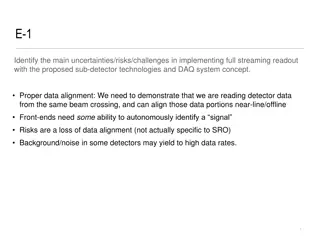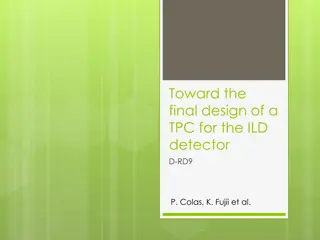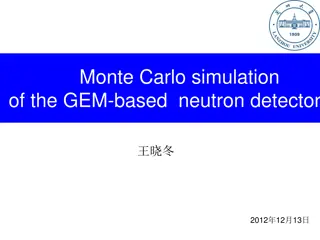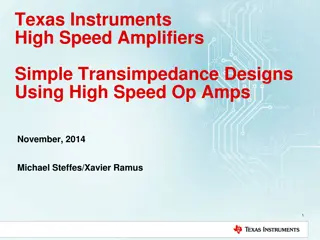Front-End Amplifier Design for BES CGEM Detector
Designers from INFN-Torino, Italy, IHEP-China, and Politecnico di Torino collaborated on creating a front-end amplifier for the BES CGEM detector. The amplifier features a channel structure with high bandwidth comparators, CR-RC4 shapers, and conjugated poles. It also incorporates a preamplifier using a low noise charge-sensitive amplifier strategy and a shaper structure with T-bridge networks for semi-Gaussian waveforms. This design aims to achieve specific technical constraints like a data rate of 60kHz, a detector capacitance of 100pF to 150pF, and a time resolution of 3ns. The layout size is 5mm x 5mm, utilizing UMC 110nm 1P8M CMOS process. The performance and results of this design will be presented at the 4th LNF Workshop on Cylindrical GEM Detectors.
Download Presentation

Please find below an Image/Link to download the presentation.
The content on the website is provided AS IS for your information and personal use only. It may not be sold, licensed, or shared on other websites without obtaining consent from the author.If you encounter any issues during the download, it is possible that the publisher has removed the file from their server.
You are allowed to download the files provided on this website for personal or commercial use, subject to the condition that they are used lawfully. All files are the property of their respective owners.
The content on the website is provided AS IS for your information and personal use only. It may not be sold, licensed, or shared on other websites without obtaining consent from the author.
E N D
Presentation Transcript
Front End Amplifier for the BES CGEM detector Chongyang Leng INFN-Torino, Italy IHEP, China Politecnico di Torino, Italy
Designers: C.Y. Leng (INFN,IHEP, Politecnico di Torino) H.S. Li (IHEP) J.Y. Chai (INFN,IHEP, Politecnico di Torino) Technical Advisors: A. Rivetti (INFN) M. Rolo (INFN) 2025/3/8 4th LNF Workshop on Cylindrical GEM Detectors 2
Design constraints Channel Per Chip: 64 Data Rate Per Channel: 60kHz Detector Capacitance: 100pF ~ 150pF Time Resolution: 3ns Charge Measurement Range: 1fC ~ 60fC Power Consumption Per Channel(FE part): 5mW Layout Size: 5mm x 5mm Process: UMC 110nm 1P8M CMOS 2025/3/8 4th LNF Workshop on Cylindrical GEM Detectors 3
Brief theoretical calculation Poisson distribution =>data rate 60kHz (time interval 16us) => full pulse width less than 1.6us (assuming the piled up<10%) => 1us pulse width for FE part. Minimum input signal 1fC with a good SNR about 5~6 => Equivalent Noise Charge about 0.2 fC Approximate equation of MOS transistors =>considering a normal gain 10mV/fC, gm=50mS required =>current about 4mA =>power consumption about 5mV per channel (FE part) 2025/3/8 4th LNF Workshop on Cylindrical GEM Detectors 4
Channel Structure High bandwidth comparator CR-RC4shapers with conjugated poles Other functional blocks LDO BANDGAP DAC 2025/3/8 4th LNF Workshop on Cylindrical GEM Detectors 5
Preamplifier implement A low noise charge sensitive amplifier strategy Current mode feedback structure, to get precise duplicated input signals for both branches Charge Sensitive Amplifier, originally proposed by Gianluigi De Geronimo 2025/3/8 4th LNF Workshop on Cylindrical GEM Detectors 6
Shaper Structure T-bridge network to get semi Gaussian waveform and set the peaking time to ~ 300ns Shapers with two stages Baseline holder: setting the quiescent point 4th LNF Workshop on Cylindrical GEM Detectors 2025/3/8 7
Performance and result Peaking time 250ns pulse width 900ns~1us 4th LNF Workshop on Cylindrical GEM Detectors 2025/3/8 8
Performance and result 2025/3/8 4th LNF Workshop on Cylindrical GEM Detectors 9
Performance and result 720 electrons @150 pF 560 electrons @100 pF 2025/3/8 4th LNF Workshop on Cylindrical GEM Detectors 10
Performance and result Detector capacitance 150pF ENC: <800 e @peaking time =250ns, Power consumption 5mW Full signal pulse width < 1us Non-linearity = 0.3% (1fC to 60fC) Noise ratio 3.2 e/pF Gain 10mV/fC 2025/3/8 4th LNF Workshop on Cylindrical GEM Detectors 11
Effort on improving the time resolution Another structure of preamplifier studied to further enhance the time resolution , by speeding up the response and take the very fast preamplifier signal for measurement Feedback resistor Same discriminator and backend structure Transimpedance amplifier with split current and a buffer 2025/3/8 4th LNF Workshop on Cylindrical GEM Detectors 12
Quick timing results Faster rising edge: ~6ns Time jitter: ~3ns Minimum signal detected: 1fC (with target SNR=2) Compromise must be made between: ENC noise in charge measurement, time resolution and power consumption 2025/3/8 4th LNF Workshop on Cylindrical GEM Detectors 13
Design blocks Structure of the 6-bits DAC Used for bias cell of the frontend and the threshold of the discriminator 2025/3/8 4th LNF Workshop on Cylindrical GEM Detectors 14
DAC implementation LSB=3.6uA Output: 0V 0.7V 64LSB@3k Area: 140um x 70um INL (all corner simulated) is less than 0.2% Layout arrangement of the DAC 2025/3/8 4th LNF Workshop on Cylindrical GEM Detectors 15
Bandgap implementation Hironori Banba, IEEE JOURNAL OF SOLID-STATE CIRCUITS, VOL. 34, NO. 5, MAY 1999 The bandgap reference is a temperature independent voltage reference circuit. It will produces a fixed voltage regardless of power supply variations, temperature changes and circuit loading from a device to generate precise references for the chip. 2025/3/8 4th LNF Workshop on Cylindrical GEM Detectors 16
Bandgap implementation Vref VS temp V=192.3uV@typical, 0~85 The best corner is: 3.7ppm Vref VS Vdd Vsupply-min=1.0V Area: 300um*300um, Power: 250uA PSR=60.1dB@100Hz PSR=57.1dB@100KHz PSR=36.8dB@1MHz 2025/3/8 4th LNF Workshop on Cylindrical GEM Detectors 17 17
Conclusions Satisfactory charge and time resolution separately, but compromise needed between them. Limited power consumption Good invariance among processes,design parameters and other conditions Simulation of the schematic almost finished and remaining layout work will start soon Supposed to be submitted at the beginning of March, 2016 2025/3/8 4th LNF Workshop on Cylindrical GEM Detectors 18 18
